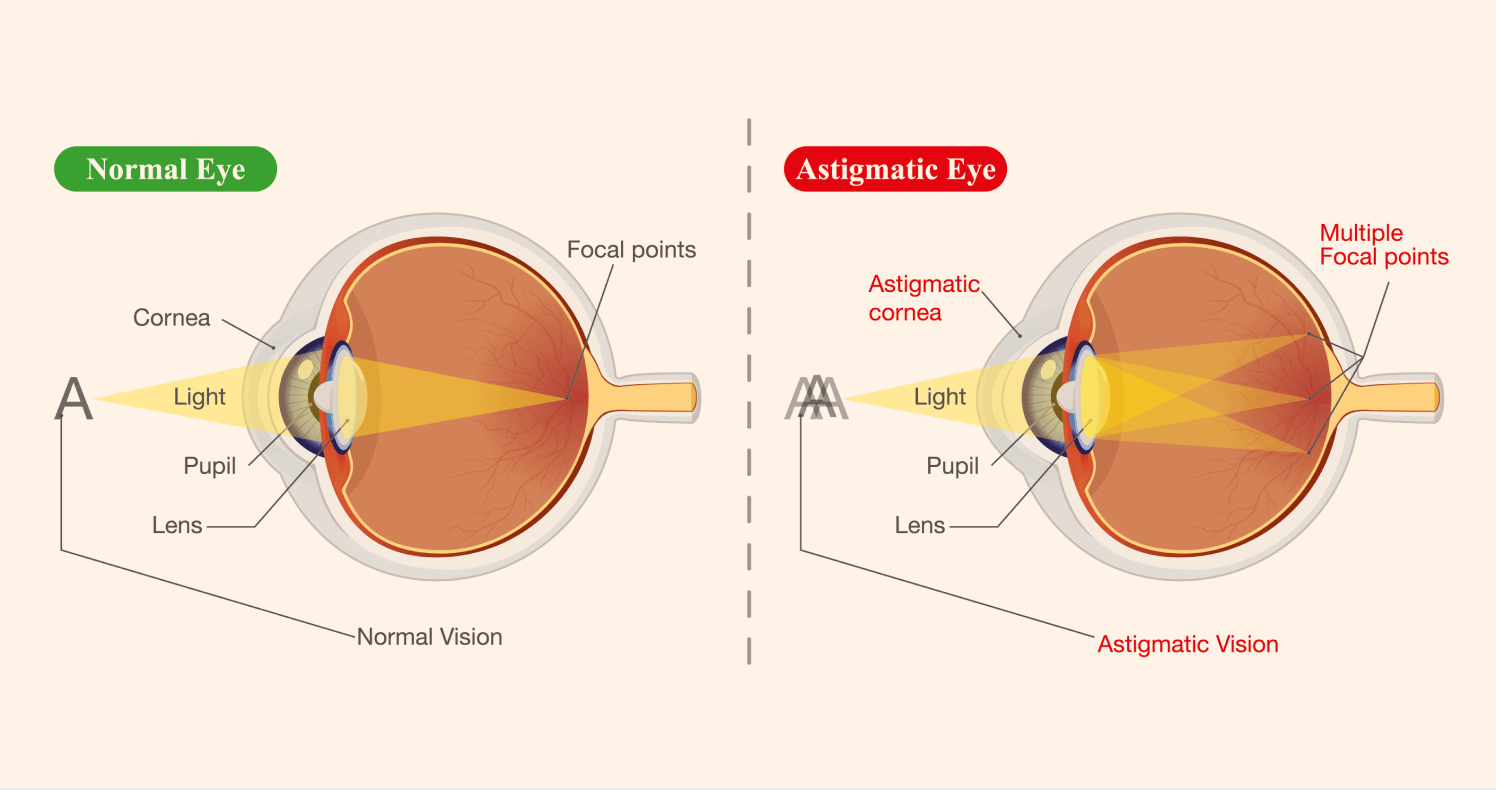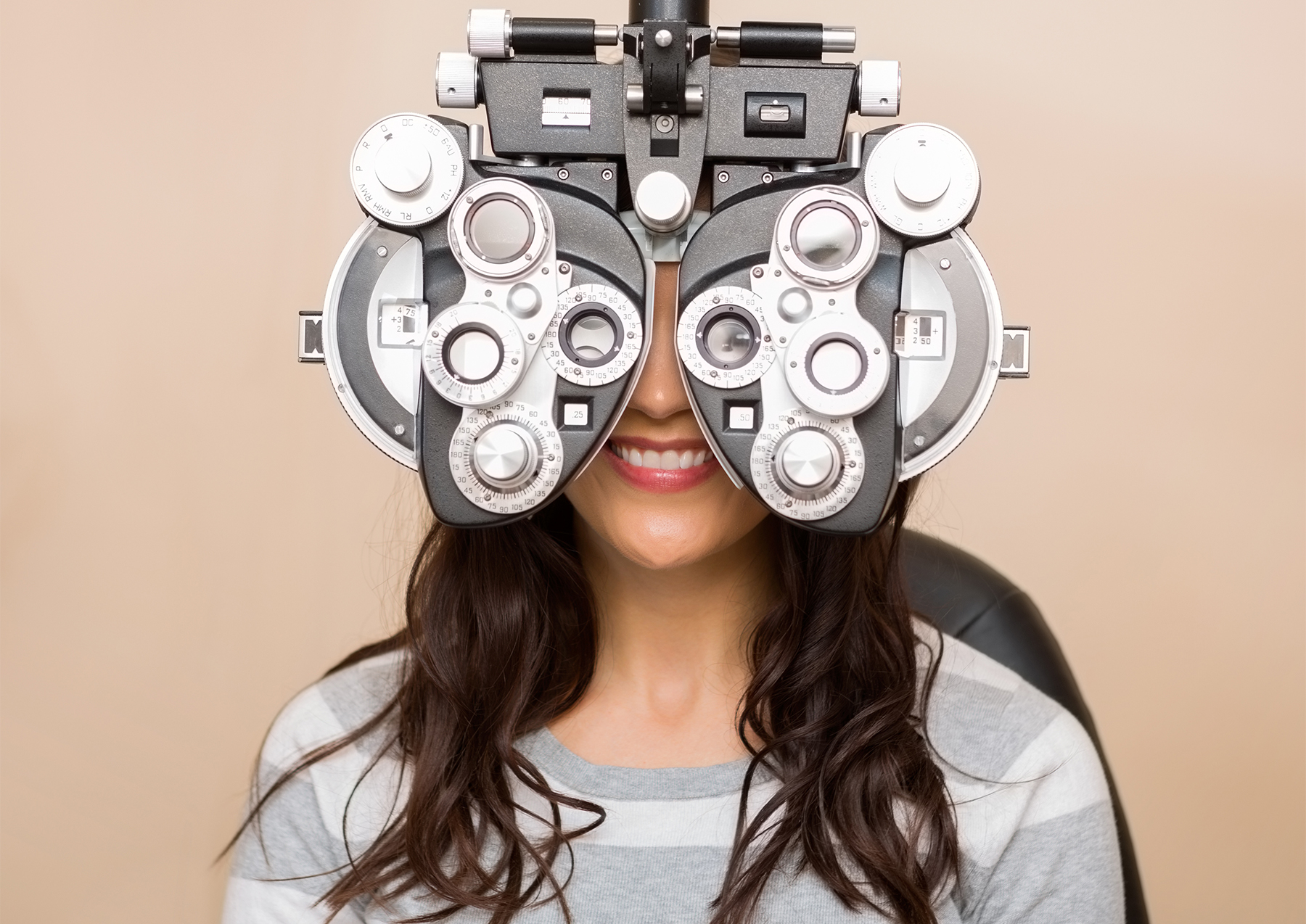
Astigmatism is an eye condition caused by an irregular shape of the cornea or lens of the eye. The surface of the cornea and lens of a normal eye is uniformly round, which allows light rays to focus on a single point on the retina and provides a clear image. However, astigmatism incorrectly bends the surface of the cornea or lens and causes light rays to focus on not one but several points on the retina. This results in a distorted and blurry image both near and far. Astigmatism can be congenital or develop over time, and it often occurs in conjunction with other refractive errors such as nearsightedness or farsightedness.
Why does astigmatism occur?
Astigmatism is usually congenital and is often diagnosed in individuals with a family history of the disorder. It is associated with an irregular shape of the cornea or lens.
The cornea or lens of the eye may have irregular shape changes that cause changes in the refraction of light rays. This change causes light rays to focus on not one but several points on the retina, resulting in astigmatism.
In addition, other factors, such as the consequences of eye injuries, some eye diseases, operations (e.g. cornea transplants) can cause astigmatism. Although in most cases astigmatism is congenital, sometimes this disorder can occur for the reasons mentioned above.
Symptoms of astigmatism
Astigmatism causes several symptoms that can vary depending on the type of astigmatism. First of all, people who have astigmatism have blurred or distorted vision for both near and far objects.
Second, astigmatism can cause fatigue and eye strain, especially after prolonged reading, computer use, or other activities that strain the vision. In addition, some people may experience headaches and a feeling of discomfort in the eyes, which are associated with excessive tension of the eye muscles when trying to focus the image.
Third, some cases of astigmatism can cause difficulty in the dark, which can cause problems such as driving at night.
However, it is important to note that these symptoms can also be related to other eye conditions, so it is recommended to see an ophthalmologist if you notice any change in your vision.

How is astigmatism diagnosed?
A refraction test, which is a standard part of an eye exam, is usually used to diagnose astigmatism. A refraction test involves a series of tests that help an optician or ophthalmologist determine the ability of a patient's eye to focus light on the retina. This includes monitoring the visual acuity of the retina where the image is captured and the structure of the eye.
In many cases, a special device called a phoropter is used, which allows the doctor to change the strength of the lenses and determine the patient's refraction values. The patient looks through the phoropter and answers questions about which image is clearer for him when the power of the lens is changed. This helps determine the correction needed.
Keratometry is another commonly used test to diagnose astigmatism. This test measures the curvature of the corneal surface and determines how the corneal surface reflects light.
Astigmatism and its types
Astigmatism is classified according to where light is focused on the retina.
Myopic astigmatism. This is a condition where one or both of the main refractive fibers focus in front of the retina. It can be direct (when the light is concentrated horizontally) or inverse (when the light is concentrated vertically).
Hyperopic astigmatism. In this case, one or both of the main refractive fibers are concentrated behind the retina. It can be direct or inverse.
Regular astigmatism. This is the most common type of astigmatism. In this case, the curvature of the horizontal and vertical axis of the cornea is different.
Irregular astigmatism. This is a rarer form of astigmatism in which the curvature of the cornea is not regular across the entire width of the cornea. It usually occurs after trauma or eye surgery. Irregular astigmatism may be more difficult to correct with glasses or contact lenses.
Treatment
The goal of treating astigmatism is to correct the problem of light refraction so that light rays can focus on a single point on the retina. This is usually achieved by using corrective optics such as glasses, contact lenses, or refractive surgery.
Glasses or contact lenses are the main treatment for astigmatism. Contact lenses can be of mixed (spherocylindrical) design for regular astigmatism, or toric design for astigmatism where the refraction of light is at different points in the eye.
Refractive surgery may also be an option for treating astigmatism in some patients. These operations use a laser to reshape the cornea to correct the refractive problem. However, not all patients can undergo this surgery, so it is important to discuss all possible treatment options with your eye doctor.
Astigmatism is a common refractive error that can cause blurred or distorted vision. Although its causes and symptoms can vary, many people can be helped with glasses, contact lenses, or refractive surgery. If you think you have symptoms of astigmatism, see your doctor for an examination and an individualized treatment plan.

Sources of information:
Hashemi, H., Khabazkhoob, M., & Jafarzadehpur, E. et al. (2012). High Prevalence of Astigmatism in the 40- to 64-Year-Old Population of Shahroud, Iran. Clinical & Experimental Ophthalmology, 40(3), 247–254.
Read, S. A., Collins, M. J., & Carney, L. G. (2007). A review of astigmatism and its possible genesis. Clinical & Experimental Optometry, 90(1), 5-19.
Nemeth, G., Szalai, E., Berta, A., & Modis, L. (2013). Astigmatism and low contrast visual acuity. Journal of Cataract & Refractive Surgery, 39(5), 692-696.
Ninn-Pedersen, K. (1996). Relationships between preoperative astigmatism and corneal optical power, axial length, intraocular pressure, gender, and patient age. Journal of Refractive Surgery, 12(7), 472–482.
De Paiva, C. S., Lindsey, J. L., Pflugfelder, S. C. (2006). Assessing the severity of keratitis sicca with videokeratoscopic indices. Ophthalmology, 113(4), 528-534.
O'Donnell, C., & Maldonado-Codina, C. (2018). A hyperopic shift in myopes using silicone hydrogel contact lenses does not correlate with lens power or baseline ametropia. Optometry and Vision Science, 95(9), 829-837.
# astigmatizmas # trumparegystė # toliaregystė # regėjimas






